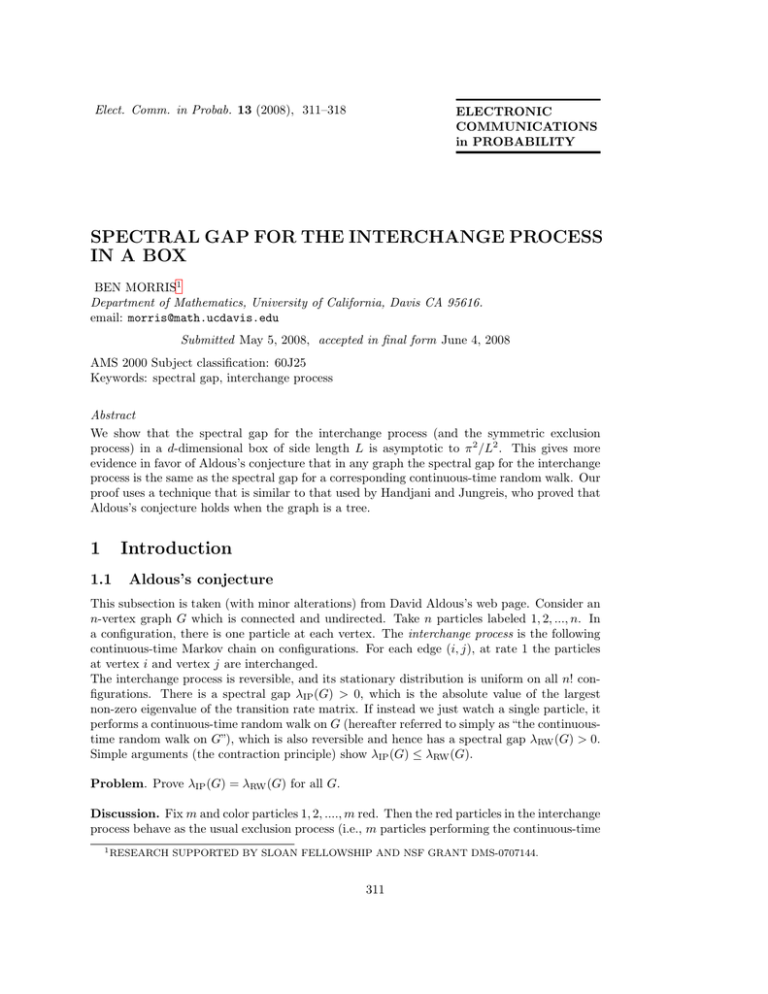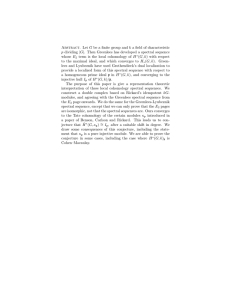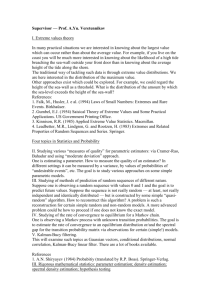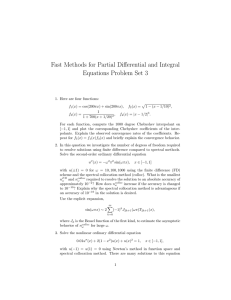SPECTRAL GAP FOR THE INTERCHANGE PROCESS IN A BOX
advertisement

Elect. Comm. in Probab. 13 (2008), 311–318
ELECTRONIC
COMMUNICATIONS
in PROBABILITY
SPECTRAL GAP FOR THE INTERCHANGE PROCESS
IN A BOX
BEN MORRIS1
Department of Mathematics, University of California, Davis CA 95616.
email: morris@math.ucdavis.edu
Submitted May 5, 2008, accepted in final form June 4, 2008
AMS 2000 Subject classification: 60J25
Keywords: spectral gap, interchange process
Abstract
We show that the spectral gap for the interchange process (and the symmetric exclusion
process) in a d-dimensional box of side length L is asymptotic to π 2 /L2 . This gives more
evidence in favor of Aldous’s conjecture that in any graph the spectral gap for the interchange
process is the same as the spectral gap for a corresponding continuous-time random walk. Our
proof uses a technique that is similar to that used by Handjani and Jungreis, who proved that
Aldous’s conjecture holds when the graph is a tree.
1
Introduction
1.1
Aldous’s conjecture
This subsection is taken (with minor alterations) from David Aldous’s web page. Consider an
n-vertex graph G which is connected and undirected. Take n particles labeled 1, 2, ..., n. In
a configuration, there is one particle at each vertex. The interchange process is the following
continuous-time Markov chain on configurations. For each edge (i, j), at rate 1 the particles
at vertex i and vertex j are interchanged.
The interchange process is reversible, and its stationary distribution is uniform on all n! configurations. There is a spectral gap λIP (G) > 0, which is the absolute value of the largest
non-zero eigenvalue of the transition rate matrix. If instead we just watch a single particle, it
performs a continuous-time random walk on G (hereafter referred to simply as “the continuoustime random walk on G”), which is also reversible and hence has a spectral gap λRW (G) > 0.
Simple arguments (the contraction principle) show λIP (G) ≤ λRW (G).
Problem. Prove λIP (G) = λRW (G) for all G.
Discussion. Fix m and color particles 1, 2, ...., m red. Then the red particles in the interchange
process behave as the usual exclusion process (i.e., m particles performing the continuous-time
1 RESEARCH
SUPPORTED BY SLOAN FELLOWSHIP AND NSF GRANT DMS-0707144.
311
312
Electronic Communications in Probability
random walk on G, but with moves that take two particles to the same vertex suppressed).
But in the finite setting, the interchange process seems more natural.
1.2
Results
Aldous’s conjecture has been proved in the case where G is a tree [7] and in the case where G
is the complete graph [5]; see also [12]. In this note we prove an asymptotic version of Aldous’s
conjecture for G a box in Zd . We show that if BL denotes a box of side length L in Zd then
λIP (BL )
→ 1,
λRW (BL )
as L → ∞.
Remark: After completing a draft of this paper, I learned that Starr and Conomos had
recently obtained the same result (see [14]). Their proof uses a similar approach, although the
present paper is somewhat shorter.
Connection to simple exclusion. Our result gives a bound on the spectral gap for the
exclusion process. The exclusion process is a widely studied Markov chain, with connections
to card shuffling [16, 1], statistical mechanics [8, 13, 2, 15], and a variety of other processes
(see e.g., [10, 6]); it has been one of the major examples behind the study of convergence
rates for Markov chains (see, e.g., [6, 3, 16, 1]). Our result implies that the spectral gap for
the symmetric exclusion process in BL is asymptotic to π 2 /L2 . The problem of bounding the
spectral gap for simple exclusion was studied in Quastel [13] and a subsequent independent
paper of Diaconis and Saloff-Coste [3]. Both of these papers used a comparison to BernoulliLaplace diffusion (i.e., the exclusion process in the complete graph) to obtain a bound of order
1/dL2 . Diaconis and Saloff-Coste explicitly wondered whether the factor d in the denominator
is necessary; in the present paper we show that it is not.
2
Background
Consider a continuous-time Markov chain on a finite state space W with a symmetric transition
rate matrix Q(x, y). The spectral gap is the minimum value of α > 0 such that
Qf = −αf,
(1)
for some f : W → R. The spectral gap governs the asymptotic rate of convergence to the
stationary distribution. Define
X
1
E(f, f ) =
(f (x) − f (y))2 Q(x, y),
2|W |
x,y∈W
and define
var(f ) =
1 X
(f (x) − E(f ))2 ,
|W |
x∈W
where
E(f ) =
1 X
f (x).
|W |
x∈W
Spectral gap for the interchange process
313
If f is a function that satisfies Qf = −λf for some λ > 0, then
λ=
E(f, f )
.
var(f )
(2)
Furthermore, if α is the spectral gap then for any non-constant f : W → R we have
E(f, f )
≥ α.
var(f )
(3)
Thus the spectral gap can be obtained by minimizing the left hand side of (3) over all nonconstant functions f : W → R.
3
Main result
Before specializing to the interchange process, we first prove a general proposition relating the
eigenvalues of a certain function of a Markov chain to the eigenvalues of the Markov chain
itself. Let Xt be a continuous-time Markov chain on a finite state space W with a symmetric
transition rate matrix Q(x, y). Let T be another space and let
function on W
P g : W → T be aP
such that if g(x) = g(y) and U = g −1 (u) for some u, then u′ ∈U Q(x, u′ ) = u′ ∈U Q(y, u′ ).
Note that g(Xt ) is a Markov chain. Let W ′ denote the collection of subsets of W of the form
g −1 (u) for some u ∈ T . We can identify the states of g(Xn ) with elements of W ′ . Let Q′
denote the transition rate matrix for g(XnP
). Note that if U, U ′ ∈ W ′ , with U = g −1 (u) for
some u ∈ T and U 6= U ′ , then Q′ (U, U ′ ) = y∈U ′ Q(u, y).
We shall need the following proposition, which generalizes Lemma 2 of [7].
Proposition 1. Let Xt , g and Q′ be as defined above. Suppose f : W → RPis an eigenvector
of Q with corresponding eigenvalue −λ and define h : W ′ → R by h(U ) = x∈U f (x). Then
Q′ h = −λh. That is, either h is an eigenvector of Q′ with corresponding eigenvalue −λ, or h
is identically zero.
Proof: Note that for all U ′ ∈ W ′ we have
X
h(U )Q′ (U, U ′ )
(Q′ h)(U ′ ) =
U ∈W ′
=
X X
f (x)
U ∈W ′ x∈U
=
X
X
Q(x, y)
y∈U ′
(Qf )(y)
y∈U ′
= −λ
X
f (y)
y∈U ′
′
= −λh(U ),
so Q′ h = −λh.
The following Lemma is a weaker version of Aldous’s conjecture. The proof is similar to the
proof of Theorem 1 in [7].
314
Electronic Communications in Probability
Lemma 2. Let G be a connected, undirected graph with vertices labeled 1, . . . , n. For 2 ≤ k ≤ n
let Gk be the subgraph of G induced by the vertices 1, 2, . . . , k. Let λRW (Gk ) be the spectral gap
for the continuous-time random walk on Gk , and define αk = min2≤j≤k λRW (Gj ). Then
λIP (G) ≥ αn .
Proof: Our prooof will be by induction on the number of vertices n. The base case n = 2
is trivial, so assume n > 2. Let W and Q be the state space and transition rate matrix,
respectively, for the interchange process on G. Let f : W → R be a function that satisfies
Qf = −λf . We shall show that λ ≥ αn . Note that a configuration of the interchange process
can be identified with a permutation π in S n , where if particle i is in vertex j, then π(i) = j.
For positive integers m and k with m, k ≤ n, we write f (π(m) = k) for
X
f (π).
π:π(m)=k
We consider two cases.
Case 1: For some m and k we have f (π(m) = k) 6= 0. Define h : V → R by h(j) =
f (π(m) = j). Then h is not identically zero, and using Proposition 1 with g defined by
g(π) = π(m) gives that if Q′ is the transition rate matrix for continuous time random walk on
G, then Q′ h = −λh. It follows that λ is an eigenvalue of Q′ and hence λ ≥ λRW (G) = αn .
Case 2: For all m and k we have f (π(m) = k) = 0. Define the suppressed process as
the interchange process with moves involving vertex n suppressed. That is, the Markov chain
with the following transition rule:
For every edge e not incident to n, at rate 1 switch the particles at the endpoints of e.
For 1 ≤ k ≤ n, let Wk = {π ∈ W : π −1 (n) = k}. Note that the Wk are the irreducible
classes of the suppressed process, and that for each k the restriction of the suppressed process
to Wk can be identified with the interchange process on Gn−1 . For k with 1 ≤ k ≤ n, define
Ek (f, f ) =
1
2(n − 1)!
X
(f (π1 ) − f (π2 ))2 Q(π1 , π2 ),
π1 ,π2 ∈Wk
and define
vark (f ) =
X
1
f (π)2 .
(n − 1)!
π∈Wk
P
(Note that for every k we have π∈Wk f (x) = 0.)
By the induction hypothesis, the spectral gap for the interchange process on Gn−1 is at least
αn−1 . Hence for every k with 1 ≤ k ≤ n we have
Ek (f, f ) ≥ αn−1 vark (f ) ≥ αn vark (f ).
Spectral gap for the interchange process
315
It follows that
n!E(f, f )
n
X
X
(f (π1 ) − f (π2 ))2 Q(π1 , π2 )
≥
1
2
=
k=1 π1 ,π2 ∈Wk
n
X
(5)
≥
k=1
n
X
(6)
(n − 1)!Ek (f, f )
αn (n − 1)!vark (f )
(4)
k=1
= αn
n X
X
f (π)2
(7)
k=1 π∈Wk
= αn n!var(f ).
(8)
Combining this with equation (2) gives λ ≥ αn .
Remark: Theorem 2 is optimal if the vertices are labeled in such a way that λRW (Gk ) is
nonincreasing in k, in which case it gives λIP (G) = λRW (G). Since any tree can be built
up from smaller trees (with larger spectral gaps), we recover the result proved in [7] that
λIP (T ) = λRW (T ) if T is a tree.
Our main application of Lemma 2 is the following asymptotic version of Aldous’s conjecture
in the special case where G is a box in Zd .
Corollary 3. Let BL = {0, . . . , L}d be a box of side length L in Zd . Then the spectral gap for
the interchange process on BL is asymptotic to π 2 /L2 .
Proof: In order to use Lemma 2 we need to label the vertices of BL in some way. Our
goal is to label in such a way that for every k the quantity λRW (Gk ) (i.e., the spectral gap
corresponding to the subgraph of BL induced by the vertices 1, . . . , k) is not too much smaller
than λRW (BL ). So our task is to build BL , one vertex at a time, in such a way that the
spectral gaps of the intermediate graphs don’t get too small.
We shall build BL by inductively building BL−1 and then building BL from BL−1 . Since
λRW (BL ) ↓ 0, it is enough to show that
βL
→ 1,
λRW (BL )
where βL is the minimum spectral gap for any intermediate graph between BL−1 and BL .
For a graph H, let V (H) denote the set of vertices in H. For j ≥ 0, let Lj = {0, . . . , j} be the
line graph with j + 1 vertices. Define γL = λRW (LL ). It is well known that γL is decreasing in
L and asymptotic to π 2 /L2 as L → ∞. It is also well known that if H and H ′ are graphs and
× denotes Cartesian product, then λRW (H × H ′ ) = min(λRW (H), λRW (H ′ )). Since BL = LdL ,
it follows that λRW (BL ) = γL .
We construct BL from BL−1 using intermediate graphs H0 , . . . , Hd , where for k with 1 ≤ k ≤ d
d−k
. Note that H0 = BL−1 and Hd = BL . We obtain Hk from Hk−1 by
we define Hk = LkL × LL−1
adding vertices to lengthen Hk−1 by one unit in direction k. The order in which the vertices
in V (Hk ) − V (Hk−1 ) are added is arbitrary.
316
Electronic Communications in Probability
Fix k with 1 ≤ k ≤ d, and define G′ = G′ (L, k) as follows. Let
V ′ = V (Hk ),
E ′ = {(u, v) : either u or v is a vertex in Hk−1 },
and let G′ = (V ′ , E ′ ). It is well known and easily shown that if H is a graph, then adding edges
to H cannot decrease λRW (H), nor can removing pendant edges. Since each intermediate graph
G̃ between Hk−1 and Hk can be obtained from G′ by adding edges and removing pendant edges,
it follows that for any such graph G̃ we have λRW (G̃) ≥ λRW (G′ ). Thus, it is enough to bound
λRW (G′ ) from below. We shall show that for any ǫ > 0 we have λRW (G′ (L, k)) ≥ (1 − ǫ)γL if
L is sufficiently large.
Let ek be the unit vector in direction k. Let
S = V (Hk−1 );
∂S = V ′ − S.
Let Xt be the continuous-time random walk on G′ , with transition rate matrix Q. Fix f :
V ′ → R with Qf = −λf for some λ > 0. For x ∈ Zd , let gk (x) denote the component of x
in the kth coordinate. Note that gk (Xt ) is the continuous-time random walk on LL . Let Q′
be the transition rate
P matrix for gk (Xt ). ′ Proposition 1 implies that if h : {0, . . . , L} → R is
defined by h(j) =
x∈V ′ f (x), then Q h = −λh. Thus if λ < γL , then g is identically zero
gk (x)=j
P
and hence x∈S f (x) = 0. Define
E(f, f ) =
X
1
(f (x) − f (y))2 Q(x, y),
′
2|V |
′
x,y∈V
and let ES (f, f ) be defined analogously,
but with only vertices in S included in the sum. Note
P
that E(f, f ) ≥ ES (f, f ). Since x∈S f (x) = 0, we have
E (f, f )
PS
≥ λRW (Hk−1 ) ≥ γL ,
2
x∈S f (x)
(9)
where the second inequality follows from the fact that Hk−1 is a Cartesian product of d graphs,
each of which is either LL−1 or LL .
Fix ǫ > 0 and let M be a positive integer large enough so that (1 − 4M −1 )−1 ≤ (1 − ǫ)−1/2 .
For each x ∈ ∂S, say that x is good if there is a y ∈ S such that x = y + iek for some
i ≤ M and |f (y)| ≤ |f (x)|/2. Otherwise say that x is bad. Let G and B denote the set of
good and bad vertices, respectively, in ∂S. Note that if x is bad and M ≤ L then f (x)2 ≤
PM
4
2
j=1 f (x − jek ) . Summing this over bad x gives
M
X
f (x)2 ≤
4 X
f (x)2
M
′
(10)
x∈V
x∈B
Note that if x is good, then there must be an x′ ∈ S of the form x − iek such that |f (x′ ) −
f (x′ + ek )| > f (x)/2M . It follows that
E(f, f )
≥ 1/4M 2 .
2
x∈G f (x)
P
(11)
Since V ′ = S ∪ B ∪ G, combining equations (11), (9) and (10) gives
X
X
f (x)2 ≤ (γL−1 + 4M 2 )E(f, f ) + 4M −1
f (x)2 ,
x∈V ′
x∈V ′
Spectral gap for the interchange process
and hence
X
f (x)2 ≤ (1 − 4M −1 )−1 (γL−1 + 4M 2 )E(f, f ).
317
(12)
x∈V ′
1
Recall that (1 − 4M −1 )−1 ≤ (1 − ǫ)− 2 , and note that since γL → 0 as L → ∞, we have
1
γL−1 + 4M 2 ≤ (1 − ǫ)− 2 γL−1 for sufficiently large L. Combining this with equation (12) gives
P
E(f, f )
≥ (1 − ǫ)γL ,
2
x∈V ′ f (x)
for sufficiently large L. It follows that λRW (G′ ) ≥ (1 − ǫ)γL for sufficiently large L and so the
proof is complete.
References
[1] Benjamini, I., Berger, N., Hoffman, C., and Mossel, E. Mixing times of the biased card
shuffling and the asymmetric exclusion process. Preprint. MR2135733
[2] Cancrini, N. and Martinelli, F. (2000) On the spectral gap of Kawasaki dynamics under
a mixing condition revisited. Journal of Math. Phys. 41, 1391–1423. MR1757965
[3] Diaconis, P. and Saloff-Coste, L. (1993). Comparison Theorems for reversible Markov
chains. Ann. Appl. Prob. 3, 696–730. MR1233621
[4] Diaconis, P. and Saloff-Coste, L. (1996). Logarithmic Sobolev Inequalities for Finite
Markov Chains, Ann. Appl. Prob. 6, 695–750. MR1410112
[5] Diaconis, P. and Shahshahani, M. (1981). Generating a random permutation with random
transpositions. Z. Wahrsch. Verw. Geb. 57, 159–179. MR0626813
[6] Fill, J. (1991). Eigenvalue bounds on convergence to stationarity for nonreversible Markov
chains with an application to the exclusion processes. Ann. Appl. Prob. 1, 62–87.
MR1097464
[7] Handjani, S. and Jungreis, D.(1996). Rate of convergence for shuffling cards by transpositions. J. Theor. Prob. 9, 983–993. MR1419872
[8] Kipnis, C., Olla, S., and Waradhan, S. (1989). Hydrodynamics and large deviations for
simple exclusion processes. Comm. Pure Appl. Math. 42, 115–137. MR0978701
[9] Lee, T.-Y. and Yau, H.-T. (1998). Logarithmic Sobolev inequality for some models of
random walk. Ann. Prob. 26, 1855–1873. MR1675008
[10] Liggett, T.M. Interacting Particle Systems. Springer, 1985. Grundlehren der mathematischen Wissenschaften; 276. MR0776231
[11] Lu, S. and Yau, H-T (1993). Spectral gap and logarithmic Sobolev inequality for Kawasaki
and Glauber dynamics. Comm. Math. Phys. 156, no. 2, 399-433. MR1233852
318
Electronic Communications in Probability
[12] Nachtergaele, B. and Starr, S. Ordering of energy levels in Heisenberg models and applications. In Joachim Asch and Alain Joye (Eds.), “Mathematical Physics of Quantum
Mechanics: Selected and refereed lectures from QMath9”, Lecture notes in Physics, Vol
690. Springer, 2006. MR2234909
[13] Quastel, J (1992). Diffusion of color in the
Comm. Pure Appl. Math., XLV, 623–679. MR1162368
simple
exclusion
process.
[14] Starr, S. and Conomos, M. Asymptotics of the spectral gap for the interchange process
on large hypercubes. Preprint. http://front.math.ucdavis.edu/0802.1368
[15] Thomas, L.E. (1980). Quantum Heisenberg ferromagnets and stochastic exclusion processes. Journal of Math. Phys. 21, 1921-1924. MR0575630
[16] Wilson, D. Mixing times of lozenge tiling and card shuffling Markov chains.
Ann. Appl. Prob., to appear. MR2023023
[17] Yau, Horng-Tzer (1997). Logarithmic Sobolev inequality for generalized simple exclusion
processes. Probab. Theory Related Fields 109 (1997), 507–538. MR1483598




